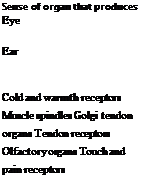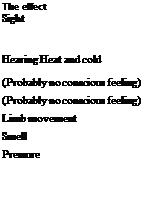In order to be able to control a machine of any sort, the operator needs some form of ‘measuring device’ (sense organs) to receive information from the information displays. For humans, these measuring devices perceive signals giving the information necessary to operate and control the process.
Table 10.1 and Table 10.2 summarise the capacity and types of the human sense organs. From these tables it may be seen that there are two characteristics of the human sense organs that are very important. First, most human sense organs span a very large range of amplitudes. The eye, for example, can cover an amplitude range that is 10 times higher than the threshold level for sight (the lowest visible light level). The sense of hearing can hear sounds that are 10 to 12 times the threshold level.
The tables also show the very wide frequency range that can be sensed by the different sense organs. However, despite the great amplitude and frequency ranges of the sense organs, there are still stimuli that lie outside the human detection ability.
TABLE 10.1
 |
 |
 |
Some Stimuli, the Sense Organs, and Their Effects
TABLE 10.2

![]()
 |
Functional Range of the Sense Organs
For the human senses there are certain electromagnetic waves that cannot be seen and certain sounds (mechanical waves) that cannot be heard. There are also certain types and qualities of stimuli (for example, ionising radiation, relative humidity) for which the human sense organs are inadequate.
It is easiest for humans to discriminate a signal if it can be compared with another signal at the same time. This is called relative discrimination. Absolute discrimination, where the size of a signal has to be determined directly without having another one to compare it with, is considerably more difficult.
Apart from recognising the frequency and amplitude of signals, human beings can sense and discriminate other dimensions such as locational and temporal relationships. Examples of this are a pulsing sound signal or a flashing light. Table 10.3 gives examples of the ability to recognise different types/variants of one and the same stimulus, and the ability to discriminate quantitatively different types of stimuli. More detailed recommendations on these stimuli are given in Chapter 3.



